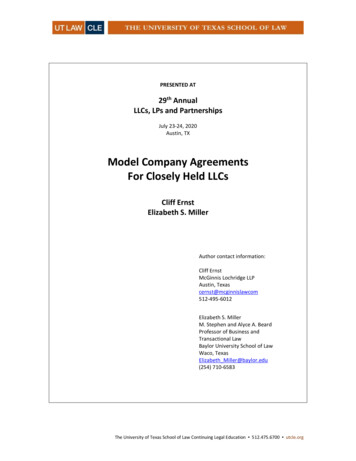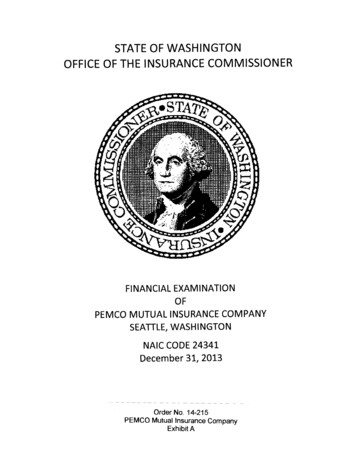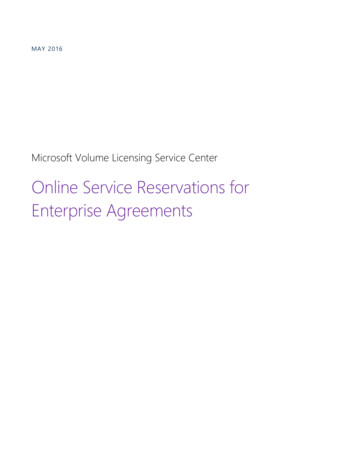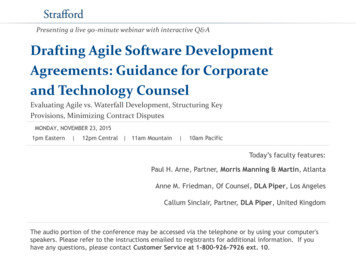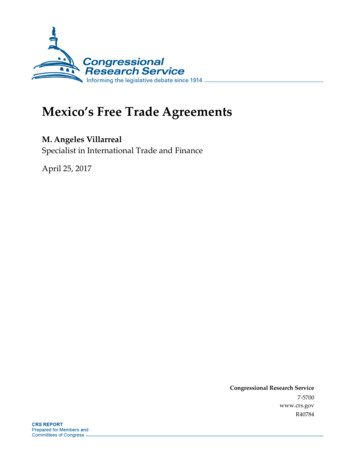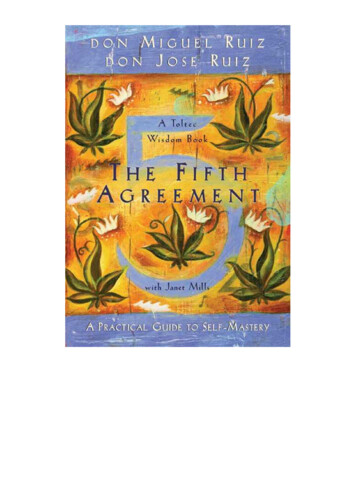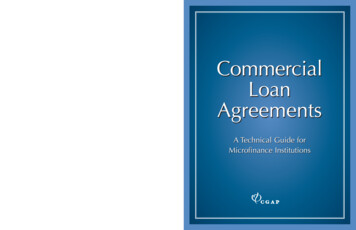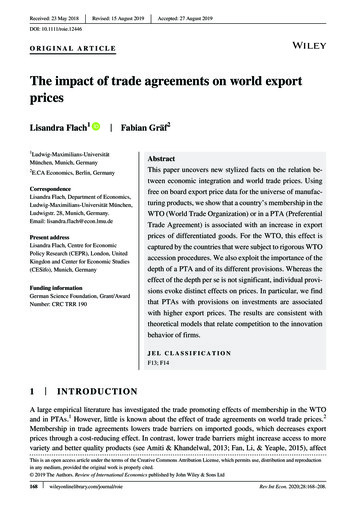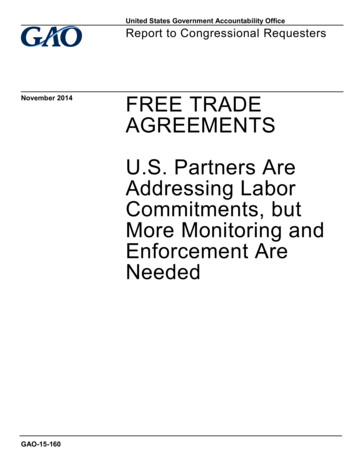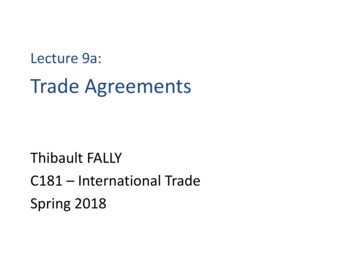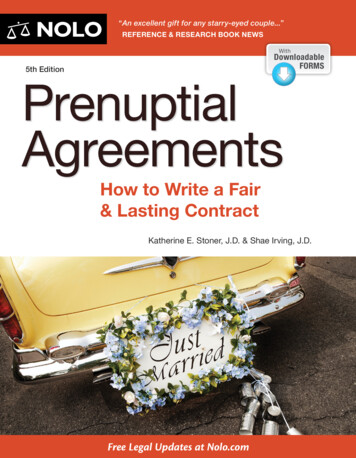
Transcription
“ An excellent gift for any starry-eyed couple.”REFERENCE & RESEARCH BOOK NEWSWithDownloadableFORMS5th EditionPrenuptialAgreementsHow to Write a Fair& Lasting ContractKatherine E. Stoner, J.D. & Shae Irving, J.D.Free Legal Updates at Nolo.com
This Book Comes With Lots ofFREE Online ResourcesNolo’s award-winning website has a pagededicated just to this book. Here you can:KEEP UP TO DATE. When there are importantchanges to the information in this book, we’llpost updates.And that’s not all.Nolo.com containsthousands of articleson everyday legal andbusiness issues, plusGET DISCOUNTS ON NOLO PRODUCTS. Geta plain-English lawdiscounts on hundreds of books, forms, anddictionary, all written bysoftware.Nolo experts and availableREAD BLOGS. Get the latest info from Nolofor free. You’ll also findauthors’ blogs.more useful books,LISTEN TO PODCASTS. Listen to authorsdiscuss timely issues on topics that interest you.WATCH VIDEOS. Get a quick introduction to asoftware, online apps,downloadable forms,plus a lawyer directory.legal topic with our short videos.WithDownloadableFORMSGet forms and more atLAW for ALLwww.nolo.com/back-of-book/PNUP.html
The Trusted Name(but don’t take our word for it)“ In Nolo you can trust.”THE NEW YORK TIMES“ Nolo is always there in a jam as the nation’s premier publisherof do-it-yourself legal books.”NEWSWEEK“ Nolo publications guide people simply through the how,when, where and why of the law.”THE WASHINGTON POST“ [Nolo’s] material is developed by experienced attorneys whohave a knack for making complicated material accessible.”LIBRARY JOURNAL“ When it comes to self-help legal stuff, nobody does a better jobthan Nolo ”USA TODAY“ The most prominent U.S. publisher of self-help legal aids.”TIME MAGAZINE“ Nolo is a pioneer in both consumer and business self-helpbooks and software.”LOS ANGELES TIMES
5th editionPrenuptialAgreementsHow to Write a Fairand Lasting ContractKatherine E. Stoner, J.D.& Shae Irving, J.D.LAW for ALL
FIFTH EDITIONSEPTEMBER 2016Cover DesignSUSAN PUTNEYBook DesignTERRI HEARSHProofreadingSUSAN CARLSON GREENEIndexJANET MAZEFSKYPrintingBANG PRINTINGISSN: 2472-596X (print) ISSN: 2472-5978 (online)ISBN: 978-1-4133-2302-3 (pbk)ISBN: 978-1-4133-2303-0 (epub ebook)This book covers only United States law, unless it specifically states otherwise.Copyright 2004, 2005, 2008, 2012, and 2016 by Nolo.All rights reserved. The NOLO trademark is registered in the U.S. Patent andTrademark Office. Printed in the U.S.A.No part of this publication may be reproduced, stored in a retrieval system, or transmitted in any form or by any means, electronic, mechanical, photocopying, recording, orotherwise without prior written permission. Reproduction prohibitions do not apply tothe forms contained in this product when reproduced for personal use. For information onbulk purchases or corporate premium sales, please contact the Special Sales Department.Call 800-955-4775 or write to Nolo, 950 Parker Street, Berkeley, California 94710.Please noteWe believe accurate, plain-English legal information should help you solvemany of your own legal problems. But this text is not a substitute forpersonalized advice from a knowledgeable lawyer. If you want the help of atrained professional—and we’ll always point out situations in which we thinkthat’s a good idea—consult an attorney licensed to practice in your state.
AcknowledgmentsThis book would never have been written without the foresight,enthusiasm, and patient support of our friends at Nolo, especially JanetPortman and Jake Warner. Nor could we have done justice to the sheerbreadth of the legal landscape without the diligent research efforts ofElla Hirst. Thanks also to Tom Hannah for his work on the preliminaryresearch, and to Stephen Stine for his excellent work on the versionyou’re reading now.We are indebted to Lisa Guerin and Emily Doskow for their editorialassistance, and to Jaleh Doane for helping with technical transitionslarge and small. Our gratitude also goes to Terri Hearsh, a talented andpatient book designer.Special thanks to Anne Lober, Peggy Williams, and everyone atDivorce Helpline for providing a wonderful meeting place halfwaybetween our homes in Pacific Grove and Berkeley—many good ideaswere hatched in those rooms.A personal note of thanks from Kathy goes to her law partners andstaff for their interest and support, and to Mickey for hanging in there.Shae would like to thank her husband, Stewart. When Shae and Stewartmarried in 2014, she was grateful they could use the guidelines in thisbook to craft a sound prenup of their own.Finally, we’d like to thank each other. Rarely does a collaborationproceed with as much grace and good humor as this one did.
About the AuthorsKatherine E. Stoner is a superior court commissioner in Monterey County,California. Prior to that, she was a certified family law specialist witha practice focused primarily on family law and mediation. She is anadjunct faculty member at Monterey College of Law, where she has taughtcommunity property, family law, and mediation since 1980.Shae Irving is the author of Living Wills & Powers of Attorney for California(Nolo) and was for many years the managing editor of Quicken WillMakerPlus (software from Nolo). Irving joined the editorial staff at Nolo in 1994after receiving her law degree Berkeley Law (Boalt Hall). She currently worksas a freelance writer and editor for Nolo and other clients who care aboutcommunication that is helpful, friendly, and true.
Table of ContentsYour Prenup Companion.11 A Prenup Primer.3Our Assumptions. 5How Prenups Work. 9How to Make a Prenup.152 Is a Prenup Right for You?.19What You Can Do With a Prenup.20What You Can’t Do With a Prenup.29Will a Prenup Work for You?.323 Deciding on the Specifics.41Evaluating Your Situation.42Talking It Through.53Will Your Prenup Pass the Fairness Test?.564 Understanding Your State’s Law.63Which Laws Apply to Your Prenup?. 64Preparing to Review the Law.65An Overview of State Law. 66Researching State Law.95Do You Still Want a Prenup?. 101
5 Assembling Your Draft Agreement: The Basics.103An Outline of Your Prenup.104Working on Your Prenup.106Choosing the Clauses for Your Prenup.108Assembling the Pages of Your Draft.190Sample Prenups.1906 Additional Provisions for Your Prenup.203Optional Paragraph 1: Estate Planning Matters.205Optional Paragraph 2: Property Transfers or Purchasesof Insurance Upon Marriage. 211Optional Paragraph 3: Provisions Applicable to Divorce.216Optional Paragraph 4: Other Matters.2407 Turning Your Draft Into a Binding Agreement. 243Planning Ahead.244Finding Good Lawyers. 245Preparing the Formal Agreement.250If Problems Arise.255Preparing an Abstract of the Agreement.258Signing the Agreement: Formalities and Fun.2598 Working Together.261Five Keys to Working Together Successfully.262A Suggested Approach to Working Together.265Communicating Effectively.266Negotiating Lovingly. 271What to Do When Problems Arise. 2769 After You’ve Made a Prenup.287Storing the Original Agreement and Copies.288Recording an Abstract or Memorandum of the Agreement.288
Following Your Own Rules.292Completing Your Estate Plan.293Reviewing the Agreement.295Changing Your Prenup: Postnuptial Agreements.296Closing Thoughts.297AppendixesA How to Use the Interactive Forms.299Editing Your Document.300Printing Out the Document.300Saving Your Document.300Accessing the Summary of State Prenuptial Laws.301List of Forms Available on the Nolo Website.301B Worksheets.303Worksheet 1: Financial Inventory.305Worksheet 2: Credit History and Spending Habits. 311Worksheet 3: Financial Outlook. 313Worksheet 4: Prenup Goals. 315Worksheet 5: The Basics of Our Prenup. 317Worksheet 6: Comparison of Prenup to Law.321C Clauses for Building Your Prenup.323Your Prenup’s Title (Mandatory for All Agreements).325The Ten Basic Paragraphs (Mandatory for All Agreements).325Optional Paragraphs. 355Financial Disclosures.364Abstract of Prenup.367Index.371
Your Prenup CompanionIf you’re planning to be married and considering a prenuptialagreement—a “prenup” for short—this book is for you. It will helpyou and your fiancé sort through the questions that most coupleshave about making this type of contract. Maybe you aren’t sure whetheryou really need a prenup. Or perhaps the two of you have decided youwant a prenup but you don’t know how to start putting it together.That’s why we’re here.We tell you what prenups are, what you can do with one, and howto figure out whether or not you want to make one. If you decide thata prenup is right for you, we show you what terms to include in it andhow to put those terms into an agreement that’s legally sound and fair toboth of you.In the first few chapters of this book, you’ll see that there are definitebenefits to making your own rules about the financial aspects ofmarriage, rather than leaving everything up to the laws of your state.You can successfully use a prenup to do the following and more: specify ground rules for buying and owning property while you aremarried coordinate and support your estate plans, to be sure that familyproperty passes as you wish, and avoid potentially divisive issues that could arise if you ever separate.What’s more, while a prenuptial agreement may not seem romantic,working together to consider and choose the terms of a prenup canactually strengthen your relationship. After all, marriage is a partner ship in every sense of the word. Learning to deal respectfully andconstructively with each other about finances is a benefit in itself. Soeven if you conclude that you don’t need a prenup, using this book canhelp you converse with each other about the important financial mattersthat are sure to arise in the course of your years together.
2 PRENUPTIAL AGREEMENTSTurn the page to start learning the basics of prenups. And, mostimportant, please accept our congratulations on your upcomingmarriage. May it be long, joyful, and prosperous.Get Updates, Forms, and More at This Book’sCompanion Page on Nolo.comYou can download the worksheets, forms, and state law summaries thatare discussed in this book at:www.nolo.com/back-of-book/PNUP.htmlWhen there are important changes to the information in this book, we’llpost updates on this same dedicated page. See Appendix A for a list offorms and resources available on the companion page on Nolo.com, andinstructions on how to use them.l
C H A P T E RA Prenup PrimerOur Assumptions. 5You Want to Be Fair. 5You’re Prepared to Make Full Disclosure. 6You’re Willing to Communicate About Finances. 7You’ll Each Work With a Lawyer. 8How Prenups Work. 9Making Your Own Rules.11What a Typical Prenup Covers.13How to Make a Prenup.15Step 1: Start Early.15Step 2: Decide Whether You Need a Prenup.16Step 3: Agree on the Specifics.16Step 4: Create a Draft Agreement.16Step 5: Write Up the Formal Agreement.17Step 6: Ask Your Lawyers to Review the Agreement.17Step 7: Sign the Agreement.17Step 8: Enjoy Your Wedding.181
4 PRENUPTIAL AGREEMENTSIn the pages that follow, we take you step by step through the processof making a prenuptial agreement, from deciding whether to haveone to preparing a final written agreement that is customized toyour situation and designed to stand the test of time. Along the way, weprovide worksheets to help you assess your finances and goals. We alsoinclude sample clauses that you can tailor to meet your needs. When it’stime to put your prenup together, you can use the resources that you’llfind on the book’s online companion page (see Appendix A).To help you see how this works for actual people, we follow threecouples through the entire process. You’ll meet Ted and Grace, Karenand Russ, and Steven and Freda—though these aren’t their real names.You’ll have a chance to see how they deal with each stage as they cometo it, and you’ll be able to read selected parts of the agreement eachcouple signs. In addition, there are a host of other fictional couples whomake cameo appearances to illustrate particular points that may arise asyou negotiate and draft your agreement.In this chapter, we’ll show you how prenups work and what youcan accomplish by preparing one. We’ll also introduce you to each ofthe steps you’ll need to take to make your own prenup. Before you getstarted, however, we’d like you to consider a few points we consideressential to making a responsible, legally valid agreement.Other Names for PrenupsIn some states, a prenuptial agreement is known as an “antenuptialagreement,” or in more modern terms, as a “premarital agreement.”Sometimes the word “contract” is substituted for “agreement,” as in“prenuptial contract.” For the sake of brevity, we’ll stick with “prenup”in this book, but occasionally you’ll find us using one of the other termsif it’s appropriate.
CHAPTER 1 A PRENUP PRIMER 5Our AssumptionsWe have written this book with a distinct—and firmly held—point ofview on the subject of prenuptial agreements. In the interest of full andfair disclosure, we want you to know up front just how we view thissubject.We think that a prenuptial agreement is more than just a legally binding contract. It is the material and financial counterpart to wedding vows.When you marry, you make what you expect and hope will be alifetime commitment to be there for each other in every way. Yourprenup should support and reflect the spirit of partnership with whichyou approach your wedding vows.Prenups aren’t always negotiated in this spirit, but we believe theyshould be. Not only that, we think this is the best way to ensure that aprenup will be binding in court, should a serious dispute ever arise.This means we’re making certain assumptions about how you willapproach your prenup. They are: You want to be fair. You are prepared to make full disclosure about your property andfinances. You are willing to communicate about finances. You’ll each work with a lawyer.Let’s look at each of these assumptions more closely.You Want to Be FairForgive us for stating the obvious. Of course you want to be fair.However, there is often more to “fairness” than meets the eye.In our view, a prenuptial agreement is fair if it meets two criteria: fair terms—that is, what you agree to benefits both of you (it’s notone-sided), and fair process—meaning that you negotiate the agreement fairly (youdon’t subject each other to undue pressure or coercion).As for the first of these criteria, it will be up to the two of you todecide what’s fair and what’s not. In fact, you may discover that each
6 PRENUPTIAL AGREEMENTSof you has a different view on what’s best in your situation. It may takesome talking and a little compromising to come up with an agreementthat seems fair to both of you, but we think you’ll find that it’s wellworth the effort.Having a fair process means taking the time to make sure that bothof you participate in making the agreement and that neither of you feelspressured into signing an agreement you’re not comfortable with. Fairprocess is the basis for the rest of our assumptions.A prenup that meets both criteria of the fairness test—its terms areequitable and you’ve mutually negotiated it—is most likely to standthe test of time in your marriage. An agreement that fails the fairnesstest will at best be a reminder of an unpleasant experience that you putaway and hope to forget about. At worst, it may erode the trust betweenyou and your betrothed, and it could even be the source of bitter andexpensive court battles in a later divorce.On the legal front, courts in most states will not enforce prenupsfound to be unfair in one or both aspects. So paying attention to fairnessalso makes it more likely that a court will enforce your premaritalagreement, if it comes to that. As you use this book, you’ll learn how toprepare an agreement that’s fair.CAUTIONA premarital agreement is a binding legal document. It’s truethat some prenups get thrown out of court because of some legal defect, butthat doesn’t mean yours will be. If you have reservations about a proposedagreement, don’t sign it with the hope that you can get out of it later. Younever know exactly what a particular court or judge might do.You’re Prepared to Make Full DisclosureOur second assumption is closely related to the first. A premaritalagreement is most likely to be viewed as fair—by you and by thecourts—if it is based upon complete and accurate financial information.This means that you should both disclose everything you own (including
CHAPTER 1 A PRENUP PRIMER 7approximate values) and all of your debts (including any obligationsfrom a prior marriage, such as child support or alimony). We are notalone in considering full disclosure basic to fairness. Virtually every staterequires that any premarital agreement be accompanied by completewritten disclosure of both parties’ financial circumstances.As you work with this book, we’ll help you figure out exactly whatyou own and what you owe. We’ll also give you detailed information tohelp you prepare the written financial disclosures that will accompanyyour prenup.You’re Willing to Communicate About FinancesLet’s face it: Although most of us marry for love rather than money,marriage is a financial partnership as well as a spiritual, emotional, andphysical union. Sooner or later, the two of you will need a workableunderstanding about how to handle your finances, even if it’s just dayto-day stuff like whether to have a joint bank account or who will paythe bills. This means that you’ll want to be able to communicate wellabout money and finances.If you intend to sign a premarital agreement, good communicationabout finances is not just desirable, it’s essential—before you sign. Ifyour communications aren’t clear, it will be next to impossible to comeup with a written document that truly represents a mutually negotiatedagreement between the two of you.Bringing up the topic of money can be hard. Having a sustainedconversation about it is even more difficult. At a time when romance ison your minds, talking about money can feel out of place. And just thethought of disagreeing can be enough to make you avoid the subject.Maybe it feels awkward to discuss old debts when you’re in the processof clearing them up and you’re confident that they’ll soon be ancienthistory. Or maybe it’s your fiancé who has the outstanding debts andyou hesitate to bring up an embarrassing subject.Whatever the reasons, money and finances can be a difficult topic formany of us to broach. If this is true for you and your betrothed, don’tbe alarmed, but don’t let it be an excuse to delay the inevitable, either.
8 PRENUPTIAL AGREEMENTSStraight talk between you is essential—the sooner the better. If you needhelp, we provide lots of tips on how to have good conversations aboutmoney, plus guidance on working with financial counselors, mediators,or other advisers.You’ll Each Work With a LawyerIf you want to end up with a clear and binding premarital agreement,you should get help from a good lawyer. In fact, you will need twolawyers—one for each of you. That may sound surprising in a self-helplegal book, but it’s true. Here’s why.As we’ll discuss in the next section, our Anglo-American legal systemviews marriage as a matter of contract between two consenting adults.The terms of the “marriage contract” are dictated by the laws of the statewhere the married people live, unless they have a premarital agreementcontaining different terms.The laws governing marriage contracts vary tremendously from stateto state. In this book, we provide some general information on eachstate’s laws relating to marriage and prenups, and we give you sometips on doing your own legal research. (See Chapter 4.) However, if youdon’t want to invest your time learning the ins and outs of your state’smatrimonial laws, a lawyer who knows the intricacies of those laws will bean important resource. The lawyer can help you put together an agreementthat meets state requirements and says what you want it to say.This explains the desirability of having one lawyer, but why two?That’s because prenuptial agreements are still scrutinized by the courts,sometimes very closely. If you want your agreement to pass muster,having an independent lawyer advise each of you can be critical. Whilemost states don’t require that each party to a prenup have a lawyer, theabsence of separate independent advice for each party is always a red flagto a judge. On a practical note, having separate legal advisers can helpyou and your fiancé craft a lasting agreement that you both understandand that doesn’t leave either of you feeling that you’ve been takenadvantage of.
CHAPTER 1 A PRENUP PRIMER 9That said, it’s best not to ask your lawyers to start writing up a draft orfinal agreement until the two of you have agreed on its essential terms.You should also put those terms in writing—either in a written outlineor a draft agreement created using the clauses in this book. A prenupprepared by a lawyer who isn’t working from terms you’ve both agreedon is likely to be one-sided and adversarial. If you provide your lawyerswith an outline or draft prepared by both of you, the whole process—and the final document—will be more balanced.All of this assumes that you select and use lawyers who are not onlycompetent and experienced in matrimonial law but who are also capableof supporting the two of you in negotiating and writing up a loving, clear,and fair agreement. You also don’t want to spend a fortune on lawyersdoing background work you could handle yourselves. Finding the rightlawyers can take some time, but it’s worth the effort. This book gives yousome suggestions on how to find and work with good lawyers in a waythat both cuts your costs and supports your relationship. (See Chapter 7.)How Prenups WorkPeople have been making prenuptial agreements for thousands of years.Scholars tell us that the practice dates back to the ancient Egyptians,and that prenups have existed for many centuries in Anglo-Americantradition. In previous times, the parents of the bride and groom negotiatedthe agreement on the new couple’s behalf. These days, engaged couplesdo their own negotiating, although family members often exert influencebehind the scenes (especially if family money is involved).Contrary to popular opinion, prenups are not just for the rich. Whileprenups are often used to protect the assets of a wealthy fiancé, couplesof more modest means are increasingly turning to them for th
“ In Nolo you can trust.” THE NEW YORK TIMES “ Nolo is always there in a jam as the nation’s premier publisher of do-it-yourself legal books.” NEWSWEEK “ Nolo publications guide people simply through the how, when, where and why of the law.” THE WASHINGTON POST “ [Nolo

